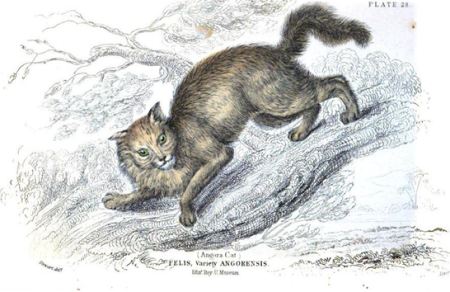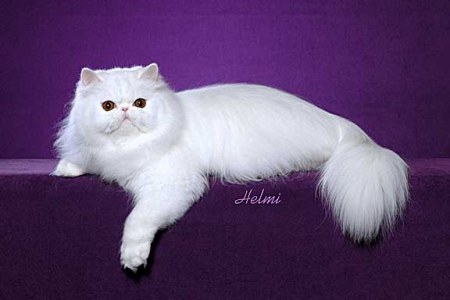This page is an attempt to clarify what the Angora cat is!

Angora cat – 1761
Introduction
Have you been confused about the meaning of “Angora Cat” and the other cat fancy terms that overlap with and surround this term? Well I have and I still might be, but this is an attempt to clear things up. The cat in the painting above, dated 1761, is interesting as it shows an Angora that has the appearance of a traditional Persian cat.
Although the term is currently (2010) and occasionally used to describe the British Angora, there is a confusing history.

History has muddied things
When long haired cat were first seen in Europe in the 16th century, in Italy, they were called Angora cats. In fact, they were named after the Turkish city of Angora (Ankara). Were these the Turkish Angora cats, the well known long haired cat?
Long haired cats in the UK were first called “Angoras” probably because long haired Persian cats were bred with Turkish Angora cats. As far as I can see, there then appeared to be an overlap between the term “Angora” meaning a long haired cat and also meaning the Turkish Angora, which is still a well established purebred cat. In the early years of the cat fancy or just before the cat fancy got off the ground the Persian, however, was the main long haired cat.
 |
Angora kitten — painting by the German-Hungarian painter Arthur Heyer (1872 †1931), oil on canvas, 40×50 cm. This looks like a traditional Persian Cat. Angora and Persian being interchangeable possibly. Read more about this artist |
| A page on Le Chat Angora, a painting by Jean-Honoré Fragonard discusses the Angora and visitor makes a v. useful comment. |
In the mid-19th century, cat lovers (not yet really cat fanciers it would seem) began to distinguish between the Turkish Angora and other cats with long hair that came from Persia (i.e. the Persian cat) and Russia (Russian Angoras – see below). It would also seem that authors of that time would refer to the Turkish Angora as the “Angora”. When they wrote of the Angora cat they referred to a cat that was long haired and different to the Persian cat breed.
Jean Bungartz in his book Housecats, Their Races and Varieties, describes the Persian cat as “a modification of the Angora cat, their hair is somewhat more woollier and curlier, but nevertheless still especially long..” The Persian does have a thicker coat than the Turkish Angora. However, the difference then (in 1896, the early years of the cat fancy) between these two long haired cats would seem to have been finer than today. There is now a stark difference probably mainly due to developing a cobby roundness in the Persian and leaving the Turkish Angora more normal in appearance. By the early 1900s the Persian cat had replaced the Angora cat. There were also Angoras that originated in Russia. In other words, this long haired cat was not confined to the boundaries of countries, why should it be?
As mentioned, although the Turkish Angora is now a well established cat with a very long history going back to the 14th century (see Cat History Timeline), in the middle of the 20th century (1950s) they were introduced into the UK having become “extinct” (src: Sarah Hartwell).

Recent Historical Confusion
In and around the 1960s in the UK we had, then, a fairly clear situation regarding the term “Angora cat”. It meant, as I understand it, the Turkish Angora. However, a cat breed that was named “The Angora” was developed in Britain (UK) by Maureen Silson at this time. She mated a Sorrel colored Abyssinian to a Seal Point Siamese cat (presumed Modern Siamese) in the mid 1960s. The objective was to produce a cat like the Siamese with ticked points (see Agouti ticked coat![]() , which shows ticked hairs). The offspring were cinnamon Oriental Shorthair cats. The offspring also inherited the long hair gene. These cats are the founding cats of the current “British Angora”. I don’t know where the long hair gene that was inherited came from as both the Abyssinian and Siamese are shorthair cats.
, which shows ticked hairs). The offspring were cinnamon Oriental Shorthair cats. The offspring also inherited the long hair gene. These cats are the founding cats of the current “British Angora”. I don’t know where the long hair gene that was inherited came from as both the Abyssinian and Siamese are shorthair cats.
The British Angora was meant to be a foreign longhaired cat designed to recreate or resemble the Turkish Angora breed. It was, it seems a “remanufacturing” of the Turkish Angora rather than a reimportation of the original Turkish Angora.
 |
| Persian Kitten – photo ©copyright Helmi Flick – please respect it. This is a modern version of the traditional Persian cat, also called an Angora cat years ago – see painting of Angora kitten, above. |
Clearing up the Confusion?
Obviously, as the British Angora was a kind of Turkish Angora but not the real thing and because its name caused confusion the breed was renamed the Oriental Longhair in the UK.
I think, confusingly, the current edition of the The Encyclopedia of the Cat uses the term “Angora” to describe the Oriental Longhair. The author (Dr. Bruce Fogle DVM) does, however, say that the other names for the Oriental Longhair are:
- Javanese (Europe) – Comment: the Javanese cat breed (see picture above) is also a name of a breed in America referring to a Modern Siamese cat (foreign appearance) and with long hair and unconventional (non-traditional) pointing. I am making the presumption that the Javanese in Europe means continental Europe (all of Europe except the UK)
- Previously Oriental Longhair – Comment: Yes, in the United States, the Oriental Longhair is now called the Javanese.

Angora cat 1894
Photo by Le Petit Poulailler (Flickr)
Conclusion
As I understand the current situation, the term “Angora cat” applies to the Turkish Angora and has no real use other than that, although there are vestiges of its former use from times gone by, which raise their head occasionally, as is the case for the British Angora, which is now renamed the Oriental Longhair. At the beginning of the cat fancy (late 1800s and early 1900s) the term was used to mean a long haired cat. Why not read about the cat fancy mashup?
Angora Cat — Sources:
- http://www.messybeast.com
- http://www.palantir.co.uk
- The Encyclopedia of the Cat by Bruce Fogle DVM

Your very beautiful cat reminds me very much of my first love. Her name was Rosy and was colored and marked just like yours. That was many years ago and we said she was an Angora barn cat. I had her many years and she was a love. She produced some beautiful kittens, not all of them as long haired as her. I have since had a Black Smoke Persian, a Siamese, a Cream Persian and now have a Russian Blue and Brown Tabby. The last two are rescue cats.
Hi Carol. Thanks for commenting. You have had some superb cats by the sound of it.
My beautiful angora Persian mix- my princess/my miss attitude.
Can you tell me if my baby is an Angora?
Cathi, thank you for showing us your beautiful white cat. The use of the word “Angora” is not clear any more so even on that basis it is not possible to tell if your cat is an Angora cat.
The word “angora” probably refers to Turkish Angora these days and that is a very old breed of cat and the genes that make that cat have probably spread far and wide to many countries therefore it is quite possible some of those genes are in your cat.
But in the meantime all we can say for sure is your cat is beautiful and will be described as a domestic shorthair cat or random bred cat, formally. Sorry that I cannot say anything more precise than that and thanks again for visiting.
That muzszle shape indicates Foreign influence (Oriental, Havana Brown etc).
Okay thanks so much for your response. I am not interested in papers and such for him. I just wanted to know what to tell people when they ask me what he is because he if very different from the average cat! Thanks again! Carmen Williams California USA
Carmen, sometimes individual cats look special or different just like people. I think he is an example. Very strong looking face. The original Turkish Angora does not have a long, strong “snout” as you call it (“muzzle” is probably the better word). The Maine Coon has a strong muzzle. He may have some Maine Coon in him too.
I found this lovely male cat and I’m wondering if he is a Turkish angora cat. His snout is longer than any cat I have ever seen and he has britches. He has lime green eyes. He is very loving and intelligent.
He has a very strong male cat face. The Turkish Angora cat genes are everywhere, inside many cats because this is an ancient cat breed. You probably can say with some certainty that he has some Turkish Angora in him.
However, in the USA you have to have cat association registration papers to prove your cat is purebred, pedigree.
Thanks for showing me your cat.